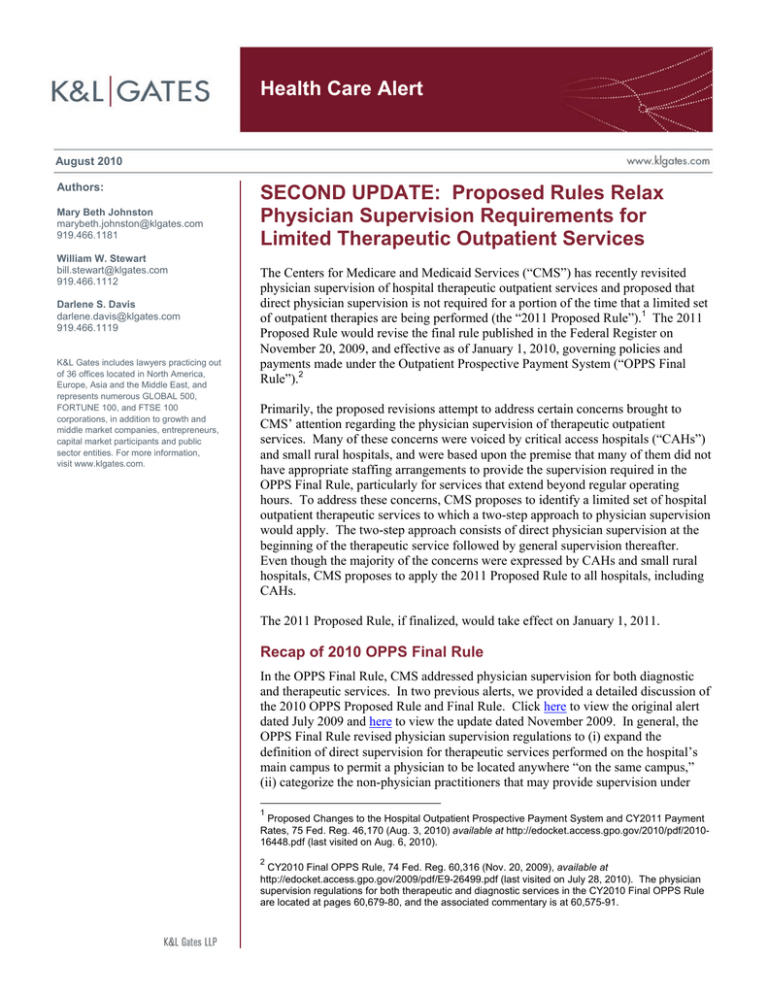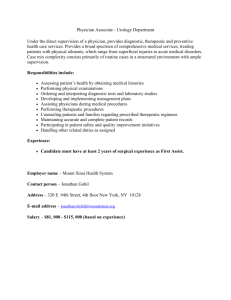
Health Care Alert
August 2010
Authors:
Mary Beth Johnston
marybeth.johnston@klgates.com
919.466.1181
William W. Stewart
bill.stewart@klgates.com
919.466.1112
Darlene S. Davis
darlene.davis@klgates.com
919.466.1119
K&L Gates includes lawyers practicing out
of 36 offices located in North America,
Europe, Asia and the Middle East, and
represents numerous GLOBAL 500,
FORTUNE 100, and FTSE 100
corporations, in addition to growth and
middle market companies, entrepreneurs,
capital market participants and public
sector entities. For more information,
visit www.klgates.com.
SECOND UPDATE: Proposed Rules Relax
Physician Supervision Requirements for
Limited Therapeutic Outpatient Services
The Centers for Medicare and Medicaid Services (“CMS”) has recently revisited
physician supervision of hospital therapeutic outpatient services and proposed that
direct physician supervision is not required for a portion of the time that a limited set
of outpatient therapies are being performed (the “2011 Proposed Rule”).1 The 2011
Proposed Rule would revise the final rule published in the Federal Register on
November 20, 2009, and effective as of January 1, 2010, governing policies and
payments made under the Outpatient Prospective Payment System (“OPPS Final
Rule”).2
Primarily, the proposed revisions attempt to address certain concerns brought to
CMS’ attention regarding the physician supervision of therapeutic outpatient
services. Many of these concerns were voiced by critical access hospitals (“CAHs”)
and small rural hospitals, and were based upon the premise that many of them did not
have appropriate staffing arrangements to provide the supervision required in the
OPPS Final Rule, particularly for services that extend beyond regular operating
hours. To address these concerns, CMS proposes to identify a limited set of hospital
outpatient therapeutic services to which a two-step approach to physician supervision
would apply. The two-step approach consists of direct physician supervision at the
beginning of the therapeutic service followed by general supervision thereafter.
Even though the majority of the concerns were expressed by CAHs and small rural
hospitals, CMS proposes to apply the 2011 Proposed Rule to all hospitals, including
CAHs.
The 2011 Proposed Rule, if finalized, would take effect on January 1, 2011.
Recap of 2010 OPPS Final Rule
In the OPPS Final Rule, CMS addressed physician supervision for both diagnostic
and therapeutic services. In two previous alerts, we provided a detailed discussion of
the 2010 OPPS Proposed Rule and Final Rule. Click here to view the original alert
dated July 2009 and here to view the update dated November 2009. In general, the
OPPS Final Rule revised physician supervision regulations to (i) expand the
definition of direct supervision for therapeutic services performed on the hospital’s
main campus to permit a physician to be located anywhere “on the same campus,”
(ii) categorize the non-physician practitioners that may provide supervision under
1
Proposed Changes to the Hospital Outpatient Prospective Payment System and CY2011 Payment
Rates, 75 Fed. Reg. 46,170 (Aug. 3, 2010) available at http://edocket.access.gpo.gov/2010/pdf/201016448.pdf (last visited on Aug. 6, 2010).
2
CY2010 Final OPPS Rule, 74 Fed. Reg. 60,316 (Nov. 20, 2009), available at
http://edocket.access.gpo.gov/2009/pdf/E9-26499.pdf (last visited on July 28, 2010). The physician
supervision regulations for both therapeutic and diagnostic services in the CY2010 Final OPPS Rule
are located at pages 60,679-80, and the associated commentary is at 60,575-91.
Health Care Alert
certain circumstances, and (iii) clarify that the
therapeutic outpatient rules also apply to CAHs.
Thus, the OPPS Final Rule required that a physician
or non-physician practitioner, in limited
circumstances, be present on a hospital or CAH
campus when outpatient therapeutic services are
being performed and be immediately available to
provide assistance and direction throughout the
duration of the service.
CMS Stays Enforcement for CAHs for
CY2010
In response to the concerns about the OPPS Final
Rule, CMS issued a statement on March 15, 2010,
stating that it will not enforce the rules for
supervision of hospital outpatient therapeutic
procedures performed in CAHs during Calendar
Year 2010.3 This stay of enforcement only applies
to outpatient therapeutic services performed in
CAHs. Unlike hospitals paid under the Outpatient
Prospective Payment System, there is no
requirement for levels of supervision for diagnostic
services in CAHs. CMS continues to enforce all
other Medicare program requirements applicable to
CAHs.
2011 Proposed Rule
In the 2011 Proposed Rule, CMS identifies a limited
set of “nonsurgical extended duration therapeutic
services” for which it proposes to allow a reduced
level of supervision in all hospitals, including CAHs,
as compared to that required under the OPPS Final
Rule. The initial list of “nonsurgical extended
duration therapeutic services” consists of 16 codes
that relate to intravenous infusion, injection or
observation services. 4
In commentary, CMS notes that chemotherapy and
blood transfusion services are specifically excluded
from this initial list, despite correspondence from
CAHs and rural community hospitals urging CMS
to include these services. CMS states that, if these
services were added, hospitals would be required to
create internal guidelines specifying a supervision
level and staffing protocols for every “nonsurgical
extended duration therapeutic service.” Because
CMS believes hospitals would find these
requirements onerous, CMS chose not to pursue this
internal guidelines option. CMS is soliciting
comments on whether hospitals agree with its
assessment and whether general supervision is
clinically appropriate for chemotherapy, blood
transfusions and similar services.
CMS also is soliciting comments on whether other
services should be included in the list of
“nonsurgical extended duration therapeutic
services.” To qualify as such a service, four
characteristics must be present: (i) the service is for
an “extended duration” and frequently extends
beyond normal business hours; (ii) the service
involves “significant monitoring” that is usually
performed by nursing or other auxiliary staff; (iii)
the service is “low risk” such that direct supervision
typically is not required; and (iv) the service is
nonsurgical.
For services that qualify as “nonsurgical extended
duration therapeutic services,” CMS proposes (i)
direct supervision during the initiation of the service
followed by (ii) general supervision for the
remainder of the service. “Direct supervision”
continues to have the same meaning as provided in
the OPPS Final Rule and codified at 42 C.F.R. §
410.27(a)(1)(iv), which requires a physician to be
physically present on site and immediately available
to assist. The 2011 Proposed Rule also does not
change the meaning of “general supervision,”
codified at 42 C.F.R. § 410.32(b)(3)(i), which does
not require the physical presence of a physician.
3
See
http://www.cms.gov/HospitalOutpatientPPS/01_overview.asp#
TopOfPage (last visited on July 28, 2010). The notice can be
found at
http://www.cms.hhs.gov/HospitalOutpatientPPS/Downloads/W
ebNotice.pdf (last visited on July 28, 2010).
4
The codes are C8957, G0378, G0379, 96360, 96361, 96365,
96366, 96367, 96368, 96369, 96370, 96371, 96372, 96374,
96375, and 96376. 2011 Proposed Rule, 75 Fed. Reg. at
46,308.
CMS is proposing to define “initiation of the
service” as the “beginning portion of a service
ending when the patient is stable and the
supervising physician or appropriate [nonphysician] practitioner believes the remainder of the
service can be delivered safely under their general
direction and control without their physical presence
on the hospital campus or in the [provider based
August 2010
2
Health Care Alert
departments] of the hospital.”5 CMS declines to
define the term “stable,” but states that the
determination of when a patient moves from direct
to general supervision is best left to the discretion of
the supervising physician or non-physician
practitioner. CMS is considering whether the point
of transfer from direct supervision to general
supervision should be documented in the medical
record or identified in a hospital protocol. CMS is
soliciting comments on this issue and how it might
review the decision to move from direct to general
supervision to monitor for proper billing should an
adverse event occur.
In addition to the foregoing proposal, CMS also has
provided additional guidance on the Frequently
Asked Questions (“FAQs”) section of the CMS
website, which is referenced in the commentary of
the 2011 Proposed Rule.6 Therein, CMS instructs
that Emergency Department (ED) physicians can
directly supervise outpatient services. The ED
physician would still have to meet the requirements
of direct supervision, including being immediately
available. CMS references this guidance in its
commentary as an example of the flexibility that it
believes exists in the direct supervision
requirements. It is questionable, at best, whether
such an approach would alleviate the staffing
concerns raised by CAHs and small rural hospitals
and whether this truly adds flexibility for acute care
hospitals, particularly where ED physicians
typically are not credentialed to supervise non-ED
services.
Conclusion
Interested parties may submit comments on CMS’
proposal in the 2011 Proposed Rule by August 31,
2010. CMS plans to release the final rule by
November 1, 2011.
5
Id. at 46,306-07.
See CMS’s Common Questions about Supervision
Requirements for Medicare Payment of Hospital Outpatient
Services, available at
http://www.cms.gov/HospitalOutpatientPPS/05_OPPSGuidanc
e.asp#TopOfPage (last visited on July 28, 2010), cited in 2011
Proposed Rule, 75 Fed. Reg. at 46,305.
6
Anchorage Austin Beijing Berlin Boston Charlotte Chicago Dallas Dubai Fort Worth Frankfurt Harrisburg Hong Kong London
Los Angeles Miami Moscow Newark New York Orange County Palo Alto Paris Pittsburgh Portland Raleigh Research Triangle Park
San Diego San Francisco Seattle Shanghai Singapore Spokane/Coeur d’Alene Taipei Tokyo Warsaw
Washington, D.C.
K&L Gates includes lawyers practicing out of 36 offices located in North America, Europe, Asia and the Middle East, and represents numerous
GLOBAL 500, FORTUNE 100, and FTSE 100 corporations, in addition to growth and middle market companies, entrepreneurs, capital market
participants and public sector entities. For more information, visit www.klgates.com.
K&L Gates is comprised of multiple affiliated entities: a limited liability partnership with the full name K&L Gates LLP qualified in Delaware and
maintaining offices throughout the United States, in Berlin and Frankfurt, Germany, in Beijing (K&L Gates LLP Beijing Representative Office), in
Dubai, U.A.E., in Shanghai (K&L Gates LLP Shanghai Representative Office), in Tokyo, and in Singapore; a limited liability partnership (also named
K&L Gates LLP) incorporated in England and maintaining offices in London and Paris; a Taiwan general partnership (K&L Gates) maintaining an
office in Taipei; a Hong Kong general partnership (K&L Gates, Solicitors) maintaining an office in Hong Kong; a Polish limited partnership (K&L
Gates Jamka sp. k.) maintaining an office in Warsaw; and a Delaware limited liability company (K&L Gates Holdings, LLC) maintaining an office in
Moscow. K&L Gates maintains appropriate registrations in the jurisdictions in which its offices are located. A list of the partners or members in each
entity is available for inspection at any K&L Gates office.
This publication is for informational purposes and does not contain or convey legal advice. The information herein should not be used or relied upon
in regard to any particular facts or circumstances without first consulting a lawyer.
©2010 K&L Gates LLP. All Rights Reserved.
August 2010
3




